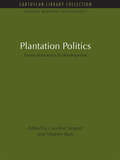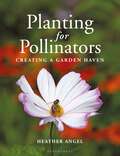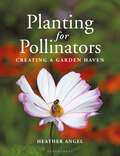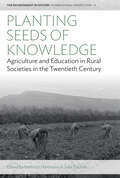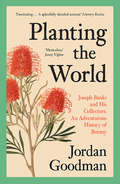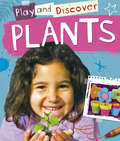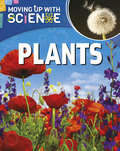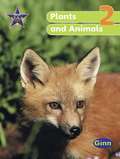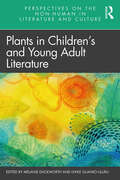- Table View
- List View
Plantago: A Multidisciplinary Study (Ecological Studies #89)
by Pieter J. C. Kuiper Marten BosThe results, published in this book, present the outcome of a cooperative research between plant ecologists, physiologists and population geneticists. The project received generous financial support from the Foundation for Bio logical Research, which is subsidized by the Netherlands Organization for Scientific Research. During the course of the Project the value of the in tegrative approach on a limited number of Plantago species and populations became evident and it was decided that the results should be published as a book. The start of the preparation of the "plantago" book was done by Dr. P. J. M. van der Aart and Dr. H. Lambers but due to their appointment as full professor of the University of Utrecht they were both unable to continue. We are greatly indebted to Van der Aart and Lambers for the groundwork they have laid. The book presents a sample of results obtained over a period of more than 10 years. Research on Plantago is still continuing, as evident from a number of publications and doctoral theses. We want to thank the authors for their pa tience and assistance to complete the job. The editorial assistance of Mrs. I. Cameron-Doornbos was extremely valuable, as well as the help of Mr. E. Leeuwinga und Mrs. N. Tolmeijer with the drawings and the help of Mrs. T. E. Stuit with the list of references.
Plantation Crops, Plunder and Power: Evolution and exploitation (Earthscan Food and Agriculture)
by James F. HancockOver the last five centuries, plantation crops have represented the best and worst of industrialized agriculture – "best" through their agronomic productivity and global commercial success, and "worst" as examples of exploitative colonialism, conflict and ill-treatment of workers. This book traces the social, political and evolutionary history of seven major plantation crops – sugarcane, banana, cotton, tea, tobacco, coffee and rubber. It describes how all of these were domesticated in antiquity and grown by small landowners for thousands of years before European traders and colonists sought to make a profit out of them. The author relates how their development and spread were closely associated with government expansionist policies. They stimulated the exploration of far off lands, were the focus of major conflicts and led to the enslavement of both native and displaced peoples. From the southern United States, Latin America and the Caribbean, to Asia and Africa, plantation crops turned social structures upside down leading to revolution and government change. The economies of whole countries became tied to the profits of these plantations, leading to internal power struggles to control the burgeoning wealth. Open warfare routinely broke out between the more powerful countries and factions for trade dominance. This book shows that from the early 1500s to today, at least one of the plantation crops was always at the center of world politics, and that this still continues today, for example with the development of oil palm plantations in Southeast Asia. Written in an accessible style, it is fascinating supplementary reading for students of agricultural, environmental and colonial history.
Plantation Crops, Plunder and Power: Evolution and exploitation (Earthscan Food and Agriculture)
by James F. HancockOver the last five centuries, plantation crops have represented the best and worst of industrialized agriculture – "best" through their agronomic productivity and global commercial success, and "worst" as examples of exploitative colonialism, conflict and ill-treatment of workers. This book traces the social, political and evolutionary history of seven major plantation crops – sugarcane, banana, cotton, tea, tobacco, coffee and rubber. It describes how all of these were domesticated in antiquity and grown by small landowners for thousands of years before European traders and colonists sought to make a profit out of them. The author relates how their development and spread were closely associated with government expansionist policies. They stimulated the exploration of far off lands, were the focus of major conflicts and led to the enslavement of both native and displaced peoples. From the southern United States, Latin America and the Caribbean, to Asia and Africa, plantation crops turned social structures upside down leading to revolution and government change. The economies of whole countries became tied to the profits of these plantations, leading to internal power struggles to control the burgeoning wealth. Open warfare routinely broke out between the more powerful countries and factions for trade dominance. This book shows that from the early 1500s to today, at least one of the plantation crops was always at the center of world politics, and that this still continues today, for example with the development of oil palm plantations in Southeast Asia. Written in an accessible style, it is fascinating supplementary reading for students of agricultural, environmental and colonial history.
Plantation Politics: Forest plantations in development (Natural Resource Management Set)
by Caroline Sargent Stephen BassPlantations are playing an increasingly important part in the development and the economies of the South. Plantation Politics is the first book to examine their rationale and purpose, exposing the misconceptions and myths that have surrounded their role, and describing the contribution they can make to sustainable development. At their best, industrial plantations can become a major asset to local development by providing raw materials, infrastructure, employment, income and environmental and recreational services. At their worst, plantations, usually imposed from a 'top-down' perspective and ignoring local needs, values and rights, have monopolized land in times of food shortage, degraded wild animal and plant populations, and destroyed habitats and landscapes. The contributors analyse the conditions appropriate for both simple and complex plantations, and the contributions each can make. Complex plantations, whether established from scratch or within natural forest, are more suitable in most cases, where they are subject to numerous different claims and needs. However, their ownership, management and silviculture present new challenges � challenges which, without the carefully researched guidelines offered here, current policy and research may well be ill-equipped to take up. Caroline Sargent is the Director and Stephen Bass is the Associate Director of the Forestry Programme at the International Institute for Environment and Development. Originally published in 1992
Plantation Politics: Forest plantations in development (Natural Resource Management Set)
by Caroline Sargent Stephen BassPlantations are playing an increasingly important part in the development and the economies of the South. Plantation Politics is the first book to examine their rationale and purpose, exposing the misconceptions and myths that have surrounded their role, and describing the contribution they can make to sustainable development. At their best, industrial plantations can become a major asset to local development by providing raw materials, infrastructure, employment, income and environmental and recreational services. At their worst, plantations, usually imposed from a 'top-down' perspective and ignoring local needs, values and rights, have monopolized land in times of food shortage, degraded wild animal and plant populations, and destroyed habitats and landscapes. The contributors analyse the conditions appropriate for both simple and complex plantations, and the contributions each can make. Complex plantations, whether established from scratch or within natural forest, are more suitable in most cases, where they are subject to numerous different claims and needs. However, their ownership, management and silviculture present new challenges � challenges which, without the carefully researched guidelines offered here, current policy and research may well be ill-equipped to take up. Caroline Sargent is the Director and Stephen Bass is the Associate Director of the Forestry Programme at the International Institute for Environment and Development. Originally published in 1992
Planted Flags: Trees, Land, And Law In Israel/palestine (Cambridge Studies In Law And Society Ser.)
by Irus Braverman9781107692275
Planted Forests: Contributions to the Quest for Sustainable Societies (Forestry Sciences #56)
by James Reid Boyle Jack K. Winjum Kathleen Kavanagh Edward C. JensenPlanted forests, from irrigated eucalypts in Brazil to Douglas-fir seedlings in the mountains of Oregon, are described and discussed by international experts. The varieties, purposes, forms, and ecological, economic and social aspects of planted forests are considered in technical details and in case studies from temperate and tropical regions of the world.
Planting: A New Perspective
by Piet Oudolf Noel KingsburyPlanting: A New Perspective, by famed landscape architects Piet Oudolf and Noel Kingsbury, characterizes a groundbreaking moment in modern horticulture; the first book to share Oudolf&’s original planting plans and the only book to explicitly guide gardeners through how Oudolf's iconic landscapes are made.
Planting and Growing (Outdoor Explorers)
by Sandy GreenA series for young children featuring activities for learning outdoors. Each book provides step-by-step instructions and talking points. At the end 'notes for adults' gives tips for getting high-quality learning from the activities. The books are a brilliant resource for an outdoor classroom setting and for children visiting a forest school.
Planting for Pollinators: Creating a Garden Haven
by Ms Heather AngelPlanting for Pollinators is an easy-to-use gardening guide to help you encourage different types of insect pollinators into your garden.Insect pollinators not only bring joy to our gardens, they also provide an essential service for our planet. Without bees, flies, hoverflies, butterflies, moths and beetles, some of our favourite foods, flowers and plants would cease to exist. Whether you have a large garden, an urban balcony or just a window box, planting to encourage pollinators is a fantastic and surprisingly easy first step in creating a wildlife-friendly space. Planting for Pollinators features a wide range of plants, with guidance on the best ways to nurture lawns and verges, pollinator predation and tips on watching and photographing wildlife. Beautifully illustrated throughout with images from award-winning wildlife photographer Heather Angel, this essential guide will show you how plants communicate with insects, and why it's so important to protect our pollinators. Organised by season and featuring more than 100 plant species – including bulbs, annuals, perennials, shrubs and climbers – this practical guide will help you to discover the short- and long-term benefits of having a variety of pollinators visit your garden.
Planting for Pollinators: Creating a Garden Haven
by Ms Heather AngelPlanting for Pollinators is an easy-to-use gardening guide to help you encourage different types of insect pollinators into your garden.Insect pollinators not only bring joy to our gardens, they also provide an essential service for our planet. Without bees, flies, hoverflies, butterflies, moths and beetles, some of our favourite foods, flowers and plants would cease to exist. Whether you have a large garden, an urban balcony or just a window box, planting to encourage pollinators is a fantastic and surprisingly easy first step in creating a wildlife-friendly space. Planting for Pollinators features a wide range of plants, with guidance on the best ways to nurture lawns and verges, pollinator predation and tips on watching and photographing wildlife. Beautifully illustrated throughout with images from award-winning wildlife photographer Heather Angel, this essential guide will show you how plants communicate with insects, and why it's so important to protect our pollinators. Organised by season and featuring more than 100 plant species – including bulbs, annuals, perennials, shrubs and climbers – this practical guide will help you to discover the short- and long-term benefits of having a variety of pollinators visit your garden.
Planting Seeds of Knowledge: Agriculture and Education in Rural Societies in the Twentieth Century (Environment in History: International Perspectives #24)
by Heinrich Hartmann Julia TischlerIn the late nineteenth and early twentieth centuries, agricultural practices and rural livelihoods were challenged by changes such as commercialization, intensified global trade, and rapid urbanization. Planting Seeds of Knowledge studies the relationship between these agricultural changes and knowledge-making through a transnational lens. Spanning exchanges between different parts of Europe, North and South America, the Indian subcontinent, and Africa, the wide-reaching contributions to this volume reform current historiography to show how local experiences redefined global practice.
Planting Seeds of Knowledge: Agriculture and Education in Rural Societies in the Twentieth Century (Environment in History: International Perspectives #24)
by Heinrich Hartmann Julia TischlerIn the late nineteenth and early twentieth centuries, agricultural practices and rural livelihoods were challenged by changes such as commercialization, intensified global trade, and rapid urbanization. Planting Seeds of Knowledge studies the relationship between these agricultural changes and knowledge-making through a transnational lens. Spanning exchanges between different parts of Europe, North and South America, the Indian subcontinent, and Africa, the wide-reaching contributions to this volume reform current historiography to show how local experiences redefined global practice.
Planting the Natural Garden
by Piet Oudolf Henk GerritsenFans of Piet Oudolf will revel in this updated edition of the book that helped launch his career.
Planting the World: Joseph Banks And His Collectors: An Adventurous History Of Botany
by Jordan GoodmanA bold new history of how botany and global plant collecting – centred at Kew Gardens and driven by Joseph Banks – transformed the earth.
Planting with Nature: A Guide to Sustainable Gardening
by Kirsty Wilson Hazel FranceBy reimagining how we design and use our gardens, we can all do our bit to support local wildlife, improve our health and help tackle the climate crisis. If we all take positive steps in our gardens, no matter how small, we can all really make a difference in the world.This book focuses on the activities and planting suitable for a Scottish climate but also contains lots of useful information relevant for gardeners throughout the UK. Practical information on planning is followed by expert guidance on:Planting for wildlife in nectar-rich borders, wildflower meadows, hedgerows, trees and shrubsBuilding for wildlife with bird boxes, bug boxes, feeders and pondsGreen gardening approaches with fruit and veg production, rain gardens, green roofs, compost making and creating new plants through propagationAttracting birds, bees, butterflies and other insects, aquatic life and nightlife
Plants: Plants (Play and Discover)
by Caryn JennerThere are all sorts of plants in the world. Why not make a plant picture, pretend to be a plant or do a plant treasure hunt?Learning through play helps children make sense of their world. The 'Play and Discover' series is perfect for developing their natural curiosity. There is lots to talk about and great ideas for creative play. Each book includes notes for parents and teachers with further activity ideas.
Plants: Ways Into Science (Moving up with Science #7)
by Peter RileyFind out all about the science in the world around us with Moving Up with Science. Written to support the National Curriculum at Key Stage 2, each title explores key scientific topics through a combination of concise information and fun experiments. Moving Up with Science: Plants explains why flowers have colourful petals; how leaves make food for plants; and how water moves inside roots and stems. Explore different types of flower and discover what happens when seeds are kept in the dark.
Plants: From Roots To Riches
by Kathy WillisOur peculiarly British obsession with gardens goes back a long way and Plants: From Roots to Riches takes us back to where it all began. Across 25 vivid episodes, Kathy Willis, Kew's charismatic Head of Science, shows us how the last 250 years transformed our relationship with plants. Behind the scenes at the Botanical Gardens all kinds of surprising things have been going on. As the British Empire painted the atlas red, explorers, adventurers and scientists brought the most interesting specimens and information back to London. From the discovery of Botany Bay to the horrors of the potato famine, from orchid hunters to quinine smugglers, from Darwin's experiments to the unexpected knowledge unlocked by the 1987 hurricane, understanding how plants work has changed our history and could safeguard our future. In the style of A History of the World in 100 Objects, each chapter tells a separate story, but, gathered together, a great picture unfolds, of our most remarkable science, botany. Plants: From Roots to Riches is a beautifully designed book, packed with 200 images in both colour and black and white from Kew's amazing archives, some never reproduced before. Kathy Willis and Carolyn Fry, the acclaimed popular-science writer, have also added all kinds of fascinating extra history, heroes and villains, memorable stories and interviews. Their book takes us on an exciting rollercoaster ride through our past and future and shows us how much plants really do matter.
Plants and Animals 2: Pupil's Book (PDF)
by John Stringer Roy Phipps Rosemary Feasey Anne GoldsworthyProviding a solution for teaching infant science, New Star Science 2 books are aimed at the second primary school year. This Pupil's Book provides practical tasks and activities, with work throughout the topic and support for group activities. The topic covered is plants and animals.
Plants and Climate Change (Tasks for Vegetation Science #41)
by Jelte Rozema Rien Aerts Hans CornelissenThis book focuses on how climate affects or affected the biosphere and vice versa both in the present and in the past. The chapters describe how ecosystems from the Antarctic and Arctic, and from other latitudes, respond to global climate change. The papers highlight plant responses to atmospheric CO2 increase, to global warming and to increased ultraviolet-B radiation as a result of stratospheric ozone depletion.
Plants and Empire: Colonial Bioprospecting in the Atlantic World
by Londa SchiebingerPlants seldom figure in the grand narratives of war, peace, or even everyday life yet they are often at the center of high intrigue. In the eighteenth century, epic scientific voyages were sponsored by European imperial powers to explore the natural riches of the New World, and uncover the botanical secrets of its people. Bioprospectors brought back medicines, luxuries, and staples for their king and country. Risking their lives to discover exotic plants, these daredevil explorers joined with their sponsors to create a global culture of botany. But some secrets were unearthed only to be lost again. In this moving account of the abuses of indigenous Caribbean people and African slaves, Schiebinger describes how slave women brewed the "peacock flower" into an abortifacient, to ensure that they would bear no children into oppression. Yet, impeded by trade winds of prevailing opinion, knowledge of West Indian abortifacients never flowed into Europe. A rich history of discovery and loss, Plants and Empire explores the movement, triumph, and extinction of knowledge in the course of encounters between Europeans and the Caribbean populations.
Plants and Planting Plans for a Bee Garden: How to design beautiful borders that will attract bees
by Maureen LittleFor many people gardening is predominantly about plants and choosing the right combination and balance to make beautiful borders. This book will help you achieve this - and more, because it will also help you create an ecologically sound, bee-friendly garden, showing that you can have an aesthetically pleasing garden full of beautiful flowers which at the same time will attract and nurture bees. It will enable you to select bee-friendly plants, and to plan borders which are beneficial to bees, encouraging these most valuable of insects to come to your garden over and over again, both for sustenance and to aid pollination. It contains a wide range of practical, beautiful and easy-to-follow planting plans for bee-friendly gardens of all sizes, including: - Traditional mixed, cottage, and colour themed borders - 'Designer' and 'natural' borders - Borders for acid and alkaline soils - Ideas for container planting This book will be of interest to every gardener who cares for the plight of the honeybee and other bees.
Plants, Health and Healing: On the Interface of Ethnobotany and Medical Anthropology (Epistemologies of Healing #6)
by Elisabeth Hsu Stephen HarrisPlants have cultural histories, as their applications change over time and with place. Some plant species have affected human cultures in profound ways, such as the stimulants tea and coffee from the Old World, or coca and quinine from South America. Even though medicinal plants have always attracted considerable attention, there is surprisingly little research on the interface of ethnobotany and medical anthropology. This volume, which brings together (ethno-)botanists, medical anthropologists and a clinician, makes an important contribution towards filling this gap. It emphasises that plant knowledge arises situationally as an intrinsic part of social relationships, that herbs need to be enticed if not seduced by the healers who work with them, that herbal remedies are cultural artefacts, and that bioprospecting and medicinal plant discovery can be viewed as the epitome of a long history of borrowing, stealing and exchanging plants.
Plants in Children’s and Young Adult Literature (Perspectives on the Non-Human in Literature and Culture)
by Melanie DuckworthFrom the forests of the tales of the Brothers Grimm to Enid Blyton’s The Faraway Tree, from the flowers of Cicely May Barker’s fairies to the treehouse in Andy Griffith and Terry Denton’s popular 13-Storey Treehouse series, trees and other plants have been enduring features of stories for children and young adults. Plants act as gateways to other worlds, as liminal spaces, as markers of permanence and change, and as metonyms of childhood and adolescence. This anthology is the first compilation devoted entirely to analysis of the representation of plants in children’s and young adult literatures, reflecting the recent surge of interest in cultural plant studies within the environmental humanities. Mapping out and presenting an internationally inclusive view of plant representation in texts for children and young adults, the volume includes contributions examining European, American, Australian, and Asian literatures and contributes to the research fields of ecocriticism, critical plant studies, and the study of children’s and young adult literatures.


